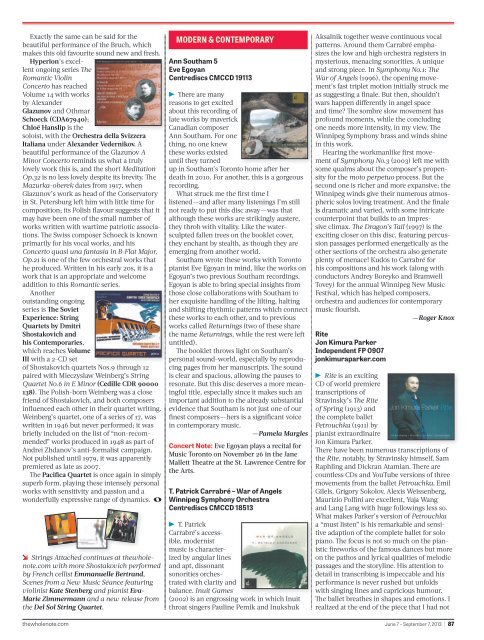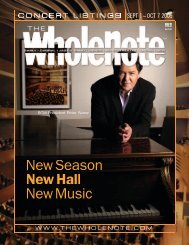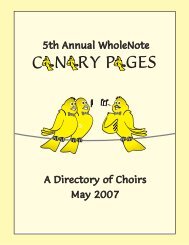work is a large and lush canvas with Lortieforming a perfect musical partnership withthe orchestra. Saugefleurie had its originsin a poem by Robert de Bonnières and herethe prominent use of horns and chromaticharmonies shows the clear influence ofWagner. (Unlike many of his French contemporaries,d’Indy was a staunch Wagnerite).Also with a literary connotation is the orchestralsuite Medée, written for a tragedy byCatulle Mendès. <strong>The</strong> Iceland Symphonyperforms with a sensitive assurance,ably capturing the orchestral colours andcontrasting moods in this story of doomedlove, thus rounding out a most satisfyingrecording.This is a fine addition in the series devotedto the “Samson of music,” one which ishelping bring to light certain works that upto now have unjustly languished in obscurity.D’Indy would be gratified!—Richard HaskellJourneys: Tchaikovsky – Souvenir deFlorence; Schoenberg – Verklärte NachtEmerson String Quartet; Paul Neubauer;Colin CarrSony 887254 70602!!Firstly, I mustadmit my prejudiceagainst the EmersonString Quartet wasinitiated by a keendisappointment andlingering dislike oftheir Beethoven StringQuartets cycle of themid-1990s issued by DG. To my ears, thosecoldly efficient, shiny performances displayedno empathy at all for the human being behindthe scores. So it was with some trepidationthat I approached this new CD, recordedjust last year, but the interpretations areexemplary!Verklärte Nacht is a particular favouriteof mine, both in the original sextet <strong>version</strong>of 1899 and the opulent <strong>version</strong> for stringorchestra revised in 1943. <strong>The</strong>re is also a<strong>version</strong> for piano trio by Eduard Steuermann,a pupil of Schoenberg, of which severalperformances are available. <strong>The</strong> Emersonsare right on the mark here. <strong>The</strong>ir toweringperformance is completely focused withimpeccable ensemble. Sensitive to everynuance and reading between the notes, thegroup appears to be totally absorbed by thebeauty of the score and, just maybe, mindfulof the melodrama and imagery of the RichardDehmel poem that inspired it. Arguably, thisperformance sweeps the board.Souvenir de Florence is an exhilarating,less familiar four-movement sextet byTchaikovsky. It enjoys the same attention fromthe players who turn in a solid and joyousperformance of this beautifully decoratedscore that will surely convert new listenersinto fans of this captivating, abundantly energeticopus.<strong>The</strong> recording producer and engineer,Da-Hong Seetoo, deserves an award forachieving such stunning realism andimmediacy with apparent ease. This is aninspired disc that belongs on your shelf.—Bruce SurteesMahler – Symphony No.1London Philharmonic Orchestra;Vladimir JurowskiLPO LPO-00070!!<strong>The</strong> late release ofa 2010 performance ofMahler’s SymphonyNo.1 on the LondonPhilharmonic’s houselabel reveals a youngconductor, VladimirJurowski, leading anenthusiastic and quitecapable orchestra in repertoire he evidentlyhas not quite come to terms with. This ismost evident in the first movement, whereJurowski’s rigid phrasing robs the music ofmuch of its charm and freshness. <strong>The</strong> noveltyof this particular performance is the inclusionof a fifth movement titled “Blumine”(Flowers) inserted between the first andAlthough she doesn’t really do anymore than her collaboratorson her latest CD featuringSchubert’s String Quintet andSchoenberg’s Verklärte Nacht, theterrific Janine Jansen gets virtuallysolo credit and attention onthe cover (Decca 478 3551). Herusual musical intelligence and sensitivity,however, is clearly matchedby violinist Boris Brovtsyn, violistsMaxim Rysanov and AmihaiGrosz, and cellists Torleif<strong>The</strong>déen and Jens Peter Maintz.Schoenberg arranged VerklärteNacht for string orchestra, butwhat a ravishing and entrancingwork it is in this originalsextet form. Written in 1899,well before his journey into atonality, itremains a stunningly beautiful late-Romanticwork, given an exemplary performance here.<strong>The</strong> quality is just as high in the SchubertString Quintet, with impeccable balancebetween the voices revealing the intricateinner details with perfect clarity, andfar more successfully than most ensembles.Attention to detail, never for its own sake butalways with the aim of enriching the interpretation,is one of Jansen’s great strengths,and her leadership here is evident. This ismusic-making of the highest quality, andas engrossing and satisfying a performanceTERRY ROBBINSsecond movements, an addition which wasdeleted by Mahler after three performancesand was presumed lost until it resurfacedin 1966. Over 20 recordings have includedthis movement since then, but consideringthe flood of recordings we have experiencedlately it’s still quite a rarity. Jurowski’s freakishlymuscular interpretation of this delicatemovement is certainly no bed of flowers, andfor my taste the plebeian lack of perfumespoils the contrast with the country bumpkincharm of the following Scherzo, which seemsto pass by in a flash in its wake. Having optedto reclaim the past by the inclusion of theextra movement, Jurowski inexplicably givesin to current revisionism by assigning thecelebrated double bass solo that launches theensuing bizarre funeral march to the entiresection according to the specious reasoningof the latest Mahler edition. Thankfully bythis point the conductor is beginning to showsome real enthusiasm, finally hitting hisstride in the hyper-theatrical grand finale andeventually saving the day with a fiery conclusion.<strong>The</strong> recorded sound from the recentlyrenovated Royal Festival Hall is quite acceptablewith no discernible distractions.—Daniel Foleyof this wonderful work as youcould wish for.Another of Decca’s youngEuropean superstar violinists,Julia Fischer, has a newCD of the Bruch and DvořákViolin Concertos, withDavid Zinman leading theTonhalle-Orchester Zürich(Decca 478 3544). In the old LP days,the Bruch Violin Concerto in G Minorwas nearly always paired withthe Mendelssohn, but theDvořák makes a surprisinglygood companion. <strong>The</strong> two workswere written only about 12 yearsapart, and share similarities inform — as indeed they do with theMendelssohn. Fischer clearly has agreat affection and affinity for theDvořák: her mother is Czech and studied inPrague, and the concerto was one of the firstthat Fischer studied as a child. It’s a lovelywork that has never really established itselfat the top of the standard repertoire. Fischerbelieves that this is changing; it wouldcertainly be difficult to find a more convincingargument than the one she presents here.From the very strong opening, through thebeautiful slow movement to the lively finale,this is a magnificent performance — intense,expansive, rich and warm throughout, with alustrous tone and lovely orchestral support.86 | June 7 – September 7, 2013 thewholenote.com
Exactly the same can be said for thebeautiful performance of the Bruch, whichmakes this old favourite sound new and fresh.Hyperion’s excellentongoing series <strong>The</strong>Romantic ViolinConcerto has reachedVolume 14 with worksby AlexanderGlazunov and OthmarSchoeck (CDA67940);Chloë Hanslip is thesoloist, with the Orchestra della SvizzeraItaliana under Alexander Vedernikov. Abeautiful performance of the Glazunov AMinor Concerto reminds us what a trulylovely work this is, and the short MeditationOp.32 is no less lovely despite its brevity. <strong>The</strong>Mazurka-oberek dates from 1917, whenGlazunov’s work as head of the Conservatoryin St. Petersburg left him with little time forcomposition; its Polish flavour suggests that itmay have been one of the small number ofworks written with wartime patriotic associations.<strong>The</strong> Swiss composer Schoeck is knownprimarily for his vocal works, and hisConcerto quasi una fantasia in B-Flat Major,Op.21 is one of the few orchestral works thathe produced. Written in his early 20s, it is awork that is an appropriate and welcomeaddition to this Romantic series.Anotheroutstanding ongoingseries is <strong>The</strong> SovietExperience: StringQuartets by DmitriShostakovich andhis Contemporaries,which reaches VolumeIII with a 2-CD setof Shostakovich quartets Nos.9 through 12paired with Mieczyslaw Weinberg’s StringQuartet No.6 in E Minor (Cedille CDR 90000138). <strong>The</strong> Polish-born Weinberg was a closefriend of Shostakovich, and both composersinfluenced each other in their quartet writing.Weinberg’s quartet, one of a series of 17, waswritten in 1946 but never performed; it wasbriefly included on the list of “non-recommended”works produced in 1948 as part ofAndrei Zhdanov’s anti-formalist campaign.Not published until 1979, it was apparentlypremiered as late as 2007.<strong>The</strong> Pacifica Quartet is once again in simplysuperb form, playing these intensely personalworks with sensitivity and passion and awonderfully expressive range of dynamics.Strings Attached continues at thewholenote.comwith more Shostakovich performedby French cellist Emmanuelle Bertrand,Scenes from a New Music Séance featuringviolinist Kate Stenberg and pianist Eva-Marie Zimmermann and a new release fromthe Del Sol String Quartet.MODERN & CONTEMPORARYAnn Southam 5Eve EgoyanCentrediscs CMCCD 19113!!<strong>The</strong>re are manyreasons to get excitedabout this recording oflate works by maverickCanadian composerAnn Southam. For onething, no one knewthese works existeduntil they turnedup in Southam’s Toronto home after herdeath in 2010. For another, this is a gorgeousrecording.What struck me the first time Ilistened — and after many listenings I’m stillnot ready to put this disc away — was thatalthough these works are strikingly austere,they throb with vitality. Like the watersculptedfallen trees on the booklet cover,they enchant by stealth, as though they areemerging from another world.Southam wrote these works with Torontopianist Eve Egoyan in mind, like the works onEgoyan’s two previous Southam recordings.Egoyan is able to bring special insights fromthose close collaborations with Southam toher exquisite handling of the lilting, haltingand shifting rhythmic patterns which connectthese works to each other, and to previousworks called Returnings (two of these sharethe name Returnings, while the rest were leftuntitled).<strong>The</strong> booklet throws light on Southam’spersonal sound-world, especially by reproducingpages from her manuscripts. <strong>The</strong> soundis clear and spacious, allowing the pauses toresonate. But this disc deserves a more meaningfultitle, especially since it makes such animportant addition to the already substantialevidence that Southam is not just one of ourfinest composers — hers is a significant voicein contemporary music.—Pamela MarglesConcert Note: Eve Egoyan plays a recital forMusic Toronto on November 26 in the JaneMallett <strong>The</strong>atre at the St. Lawrence Centre forthe Arts.T. Patrick Carrabré – War of AngelsWinnipeg Symphony OrchestraCentrediscs CMCCD 18513! ! T. PatrickCarrabré’s accessible,modernistmusic is characterizedby angular linesand apt, dissonantsonorities orchestratedwith clarity andbalance. Inuit Games(2002) is an engrossing work in which Inuitthroat singers Pauline Pemik and InukshukAksalnik together weave continuous vocalpatterns. Around them Carrabré emphasizesthe low and high orchestra registers inmysterious, menacing sonorities. A uniqueand strong piece. In Symphony No.1: <strong>The</strong>War of Angels (1996), the opening movement’sfast triplet motion initially struck meas suggesting a finale. But then, shouldn’twars happen differently in angel spaceand time? <strong>The</strong> sombre slow movement hasprofound moments, while the concludingone needs more intensity, in my view. <strong>The</strong>Winnipeg Symphony brass and winds shinein this work.Hearing the workmanlike first movementof Symphony No.3 (2003) left me withsome qualms about the composer’s propensityfor the moto perpetuo process. But thesecond one is richer and more expansive; theWinnipeg winds give their numerous atmosphericsolos loving treatment. And the finaleis dramatic and varied, with some intricatecounterpoint that builds to an impressiveclimax. <strong>The</strong> Dragon’s Tail (1997) is theexciting closer on this disc, featuring percussionpassages performed energetically as theother sections of the orchestra also generateplenty of menace! Kudos to Carrabré forhis compositions and his work (along withconductors Andrey Boreyko and BramwellTovey) for the annual Winnipeg New MusicFestival, which has helped composers,orchestra and audiences for contemporarymusic flourish.—Roger KnoxRiteJon Kimura ParkerIndependent FP 0907jonkimuraparker.com!!Rite is an excitingCD of world premieretranscriptions ofStravinsky’s <strong>The</strong> Riteof Spring (1913) andthe complete balletPetrouchka (1911) bypianist extraordinaireJon Kimura Parker.<strong>The</strong>re have been numerous transcriptions ofthe Rite, notably, by Stravinsky himself, SamRaphling and Dickran Atamian. <strong>The</strong>re arecountless CDs and YouTube <strong>version</strong>s of threemovements from the ballet Petrouchka. EmilGilels, Grigory Sokolov, Alexis Weissenberg,Maurizio Pollini are excellent, Yuja Wangand Lang Lang with huge followings less so.What makes Parker’s <strong>version</strong> of Petrouchkaa “must listen” is his remarkable and sensitiveadaption of the complete ballet for solopiano. <strong>The</strong> focus is not so much on the pianisticfireworks of the famous dances but moreon the pathos and lyrical qualities of melodicpassages and the storyline. His attention todetail in transcribing is impeccable and hisperformance is never rushed but unfoldswith singing lines and capricious humour.<strong>The</strong> ballet breathes in shapes and emotions. Irealized at the end of the piece that I had notthewholenote.com June 7 – September 7, 2013 | 87
- Page 1 and 2:
FREE!Vol 18 No 9CONCERT LISTINGS |
- Page 5 and 6:
Top 500 CEO's and their .COM Domain
- Page 9:
Institute and performances of Hande
- Page 13 and 14:
Joe Macerollo.Starting off in June,
- Page 15 and 16:
Beat by Beat | World ViewA Slow Hot
- Page 17 and 18:
Beat by Beat | Classical & BeyondSt
- Page 19 and 20:
116 13T H SEASON14MUSIC IN THEAFT E
- Page 21 and 22:
Musicat MetropolitanMusic at Metrop
- Page 23 and 24:
in harmony with the aesthetic of th
- Page 25 and 26:
Beat by Beat | Art of SongThe Songs
- Page 27 and 28:
For operas in concert in June, one
- Page 29 and 30:
acheal mccaigdirector of the Shaw F
- Page 31 and 32:
jack macquarrieLeading Seaman James
- Page 33 and 34:
is that the best jazz I’ve heard
- Page 35 and 36: A toast to jams: Between the Festiv
- Page 37 and 38: 416-593-0688(Chinese). $29-$120. Al
- Page 39 and 40: ●●7:30: Domoney Artists Managem
- Page 41 and 42: Lula Lounge June 19, 8pmTD Toronto
- Page 43 and 44: College, 540 Lakeshore Rd. W., Oakv
- Page 46 and 47: $12.50(child). Also Aug 9, 10 and 1
- Page 48 and 49: at modest cost.●●2:30: Seniors
- Page 50 and 51: ●●7:30: Brookside Music Summer
- Page 52 and 53: pubaret.com (full schedule)Jun 7 7p
- Page 54 and 55: GALAS & FUNDRAISERS●●Jun 2, 3:0
- Page 56 and 57: ●●Jun 29, 5:00: Canadian Flute
- Page 58 and 59: through different acoustic spaces o
- Page 60 and 61: Classified Advertising | classad@th
- Page 62 and 63: GREEN PAGESSUMMER MUSIC GUIDEWelcom
- Page 64 and 65: GREEN PAGESthe tutelage of some of
- Page 66 and 67: GREEN PAGESin which he will project
- Page 68 and 69: 5 Senses FestivalAugust 16 and 17Ri
- Page 70 and 71: Glick: The Hour Has Come; Halley: S
- Page 72 and 73: fiddles; Ten Strings And A Goat Ski
- Page 74 and 75: Castlereagh StreetRVE - Ravine Vine
- Page 76 and 77: and Afrocuban. ACS; 1:00: Donna Gre
- Page 78 and 79: Celebration of world cultures featu
- Page 80 and 81: FESTIVAL DIGESTVisit thewholenote.c
- Page 82 and 83: DISCOVERIES | RECORDINGS REVIEWEDIw
- Page 84 and 85: drunken soldier), his voice perfect
- Page 88 and 89: thought about the orchestra or the
- Page 90 and 91: a special guest with Jones’ trio
- Page 92: Old Wine, New Bottles | Fine Old Re
- Page 96: Paris La Belle ´ EpoqueJULY 16-AUG
















